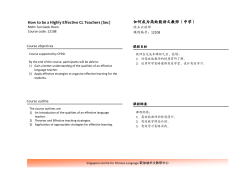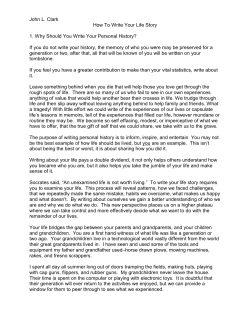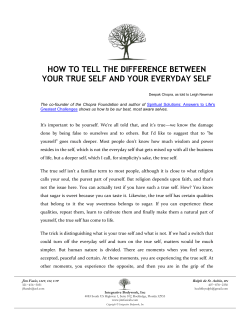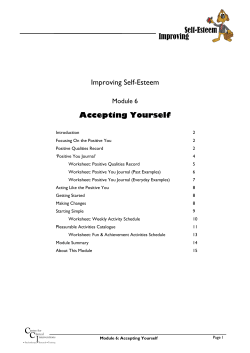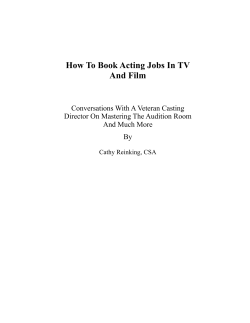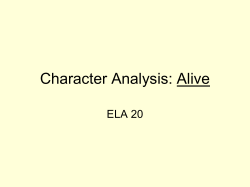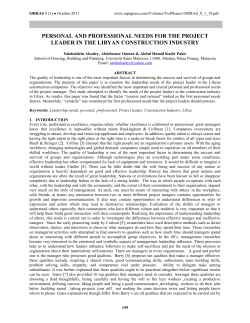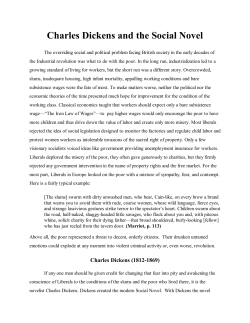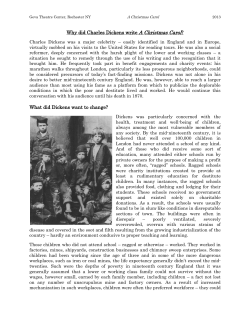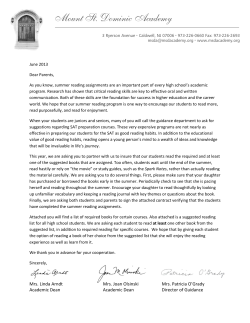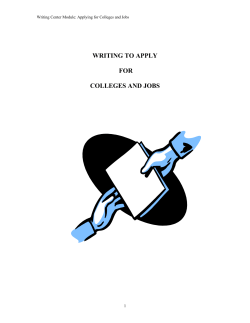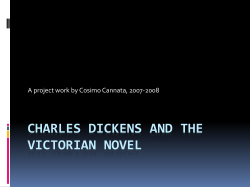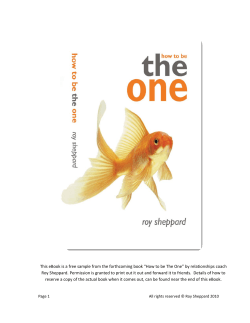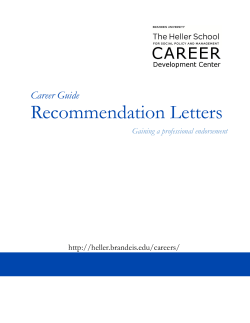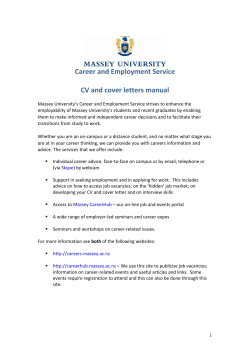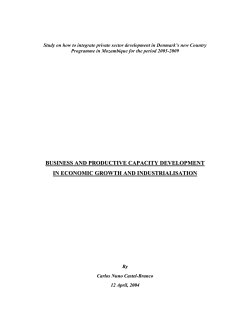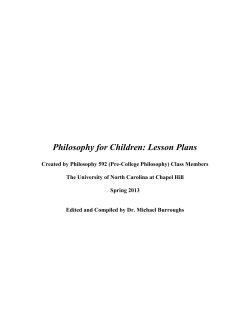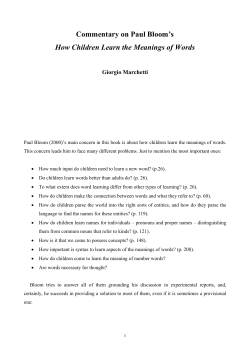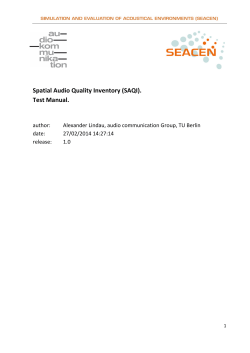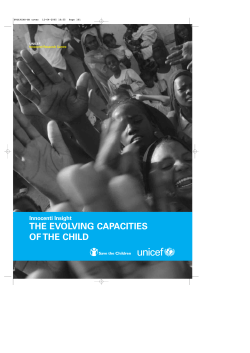
WHAT DO THE ARTS TEACH?
WHAT DO THE ARTS TEACH? Elliot W. Eisner Stanford University Low spending on the arts in schools indicates the low value placed on them. Yet the arts teach children how to exercise judgement and cope with the unexpected; they also make an unquantifiable contribution to developing understanding and enriching lives. In the opening page of Charles Dickens' Hard Times Thomas Gradgrind offers advice on educational policy to a schoolmaster: 'Now, what I want is Facts. Teach these boys and girls nothing but Facts. Facts alone are wanted in life. Plant nothing else, and root out everything else. You can only form the minds of reasoning animals upon Facts; nothing else will ever be of service to them. This is the principle on which I bring up my own children, and it is the principle on which I bring up these children. Stick to the Facts, sir!' The policy Gradgrind advanced in 1854 is not appropriate today. Contemporary society is interested in loftier, more elusive goals whose attainment is difficult to measure. Students must not only know the facts, but understand them and be able to think in imaginative, complex and critical ways. The world today requires people who can think on their own, who can InJAE 1.1 © NTAEI 2003 7 WHAT DO THE ARTS TEACH? raise telling questions and solve puzzling problems. The world outsideschool is riddled with unpredictable contingencies - there are no certainties. These conditions have implications for what and how we teach because that has something to do with the kind of minds children in future will be able to create. Experience is the primary medium of education and educational policies affect the kind of mental skills, forms of understanding, and types of literacy they will have an opportunity to acquire. In the curricula offered by schools, matters of content inclusion, content exclusion and method are important. Since time is a precious resource, how to allocate time to what we teach presents both an opportunity for students and an opportunity cost. Policies about content, form, and goals of educational programmes are of major importance in shaping what and how children think. Nice but not necessary The arts, in so far as our schools are concerned, do not represent high-status knowledge. For more than a few in the policy world they have nothing at all to do with knowledge. The arts traffic in emotion. They are largely visceral. They are thought to have little to do with abstract forms of thinking or with the kind of reasoning that abstraction makes possible. Since the school should give its garlands to the cultivation of the intellect, they are a kind of divertimento, nice but not necessary. One of the most telling indicators of the arts' position in schools is the amount of financial support they receive. According to a 1996 Office of Standards in Education (Ofsted) report, the range of expenditure in 1995/6 for visual arts education in secondary schools per child per year was from 70p to £8, with a median of £2.88 per child per year. How shall we respond? Are the arts void of abstraction? Are they non-intellectual? Do they really inform? Are they practical? This lecture will explore what the arts teach and reveal the kind of thinking the arts demand. However, one important caveat pertains to the quality of teaching: the arts can be as badly taught as any field of study but my comments are predicated on the assumption that they are well taught. One other qualification: because I was in another life a painter and a teacher of art, most of the examples are taken from the visual arts; however, the same 8 InJAE 1.1 © NTAEI 2003 issues and processes do appear in the other arts as well. WHAT DO THE ARTS TEACH? Art's lessons Work in the arts teaches children that sensitive attention to relationships is critical for creating a coherent and satisfying piece of work. The way qualities relate to each other - whether in sight or sound, through prose or poetry, whether in the choreographed movement of dance of in an actor's lines and movements - is critical. Decisions about these relationships cannot be reduced to rule; they depend upon somatic experience. This is not limited to the arts. To the extent to which the practice of science is an art, it too requires that judgements about the rightness of an idea or the beauty of a theory be determined by somatic experience. In the arts the somatic experience of relationships is a central basis for making judgements. What is striking is that so little in the school curriculum affords children the opportunity to make such judgements. The curriculum is heavily weighted towards subject matter that gives students the illusion that rightness always depends upon fealty to rule. Spelling and arithmetic are largely mimetic or rule-abiding. Not so the arts. They are most conspicuous in their insistence that relationships are central and that good relationships are achieved when mind works in the service of feeling. This is a cognitive use of the emotions, where judgement rather than rule prevails. Celebration of diversity The arts teach children that problems can have more than one solution and that questions can have more than one answer. The arts celebrate diversity. While the teacher of spelling is not particularly interested in ingenuity of response from students, the arts teacher seeks it. The arts celebrate multiple conceptions of virtue. They teach that there are many ways to see and interpret the world and that people can look through more than one window. Furthermore, this lesson is seldom taught in schools. The multiple-choice test is not objective because of the way the test items The arts.... do not represent high-status knowledge. For more than a few in the policy world they have nothing at all to do with knowledge. InJAE 1.1 © NTAEI 2003 9 WHAT DO THE ARTS TEACH? are selected; it is objective due to the way it is scored and because it makes no allowance for the exercise of judgement. Reflect for a moment on the tacit lessons of such tests. The possibility of multiple ways of addressing and solving a problem is one way in which a child's individual signature can be affixed to the work. It is ironic that at a time when educational reform pushes towards standardised assessment, uniformity of programme and homogeneity of aims, a field that provides balance to such priorities should be regarded as marginal. Surely, the greater the pressure to standardise, the greater the need for the arts. The arts teach children that in complex forms of problem-solving purposes are seldom fixed but change with circumstance and opportunity. In socalled rational approaches to problem-solving the standard paradigm is clear goals and objectives; means can be designed to attain those goals, and evaluation procedures can be used to determine if the goals and objectives have been reached. If not, more effective means can be used to recycle the process. Yet, this model is not the way life works and it's certainly not the way work in the arts proceeds. Learning in the arts requires an ability to surrender to the unanticipated possibilities of the work as it unfolds. At its best, work in the arts is not a monologue but a conversation punctuated with all of the surprises and uncertainty that really stimulating conversation makes possible. In the arts one looks for surprise that redefines goals; purposes are held flexibly. The aim is not impressing into a material what you already know but rather discovering what you don't. We know more than we can tell The arts teach children that, despite cultural bias, neither words in their literal form nor numbers as quantifiers of the world exhaust what we can know. Our linguistic capacities do not define the limits of our cognition. As Michael Polanyi says, we know more than we can tell. For students, and for those who shape educational policy, this lesson is important. The reduction of knowing to the quantifiable and the literal so that certain verification procedures can be employed is too high a price to pay for conceptualising the conditions of knowledge. The capacity of the arts, for example, to promote 10 InJAE 1.1 © NTAEI 2003 empathy as a means of understanding what others have undergone relies on the form of the work to evoke in the competent reader a certain quality of life that eludes the stripped-down features of the literal. Empathetic participation in the lives of others is not the only contribution the arts make to the enlargement of understanding. An ability to create forms that make such understanding possible in the first place attests to the human capacity and need to invent ways through which meaning can be pursued, stabilised and made public. The arts, like the sciences, help us grasp the ways in which we share with each other the reaches of our imagination and the depth of our feeling. What we share are the distinctive qualities of experience that a work of art itself makes possible. The delicate contours of a Tang dynasty vessel as well as the complex harmonies of a late Beethoven quartet are knowable whether you live in London, Beijing or Chicago, as long as you know how to enquire into them. Learning how to conduct such enquiries is a part of what it means to have an art education. If the arts are thought of as carriers of meaning, and if the concept of literacy is extended to mean the ability to encode or decode meaning within forms in which meaning can appear, then an education in the arts is one way to become literate. Broadened further, an education in the arts, like one in the sciences, is a means through which students acquire multiple forms of literacy, thus opening up meanings that different forms of representation make possible. WHAT DO THE ARTS TEACH? Subtleties and nuances The arts teach students that small differences can have large effects. They traffic in subtleties. Paying attention to subtleties is not typically a dominant mode of perception in the ordinary course of life. Typically, we see in order to recognise rather than to explore visually the subtle nuances of a visual field. How many people have really seen the facade of their own house? One test is to try to draw it. The tendency is to look at a house in order to know if you have arrived home, or to decide if it needs to be painted, or to determine if anyone's there. Seeing its visual qualities and their relationships is much less common. Yet learning to see is precisely what the arts teach. They invite students to explore the auditory contours of a musical performance, the move- InJAE 1.1 © NTAEI 2003 11 WHAT DO THE ARTS TEACH? ments of a dance, the proportions of an architectural form so they can be experienced as art forms. Seeing in such situations is in the service of feeling. This scope of aesthetic experience is not limited to the fine arts. City streets, cloud formations, billboard posters ripped from the walls of a building and displaying the luscious surface of a collage are also candidates for seeing in the service of feeling. There is, however, a difference between such forms and what are considered works of art. Works of art participate in a tradition, invested with intention by their creators and as part of a social context, they have been influenced by their history. Anything can be seen from a purely formal perspective. The perception of art works requires more. The arts teach students to think through and within a material. All art forms employ some vehicle through which images become real - music has patterned sound, dance has the expressive movement of a dancer, painting has a visual form on a canvas. Each art form imposes on its creators a set of constraints; they make certain demands. They also provide an array of affordances and offer distinctive opportunities but to realise such opportunities the child must be able to convert a material into a medium. This conversion occurs when the material mediates what the child wishes to achieve, and for this to occur the child must learn to think within the affordances and constraints of the material and to employ techniques to make possible that conversion of material to medium. Remaking ourselves through art This process of conversion occurs not only within the material but also within the child. The phrase 'work of art' refers both to the task of arting and to the results of such work. The term 'work' is both a noun and a verb, an activity whose consequences live not only in the object but in the maker. The work of art is a process and a product through which we remake ourselves. How does this remaking occur? First, works of art can defamiliarise aspects of the world by recontextualisation. Duchamp's urinal, titled The How many of us have really seen the facade of our own house? One test is to try to draw it. 12 InJAE 1.1 © NTAEI 2003 fountain and placed in a museum, represents an invitation to see in a new way what our customary form of sight has blinded us to. Duchamp's invitation illuminates not only the object but our assumptions about art. Defamiliarisation and new juxtaposition challenge our experience for they violate our expectations. They call attention not only to the work but to any aspect of the world we are able to re-see as a result. Secondly, works of art focus our attention on what would normally go unseen. This calling of attention makes vivid new ways of seeing the world and, when the arts are well taught, illustrates to students new ways in which they themselves can reframe the world for perception. Although new theories in science also represent a reframing, there is an expectation of some correspondence between a scientific representation and the reality. In the arts the scope for a no-holds-barred imaginative reframing is not constrained by such expectations. Talk about art makes special demands on those who speak about it. Think, for a moment, about what is required for anybody to describe the qualities of a trumpet solo by Miles Davis or the expressive character of a bronze sculpture by Barbara Hepworth. The task is not to replicate in language the qualities experienced. It is rather to imply, through language, qualities that are themselves ineffable, hence the trick is to say what cannot be said. WHAT DO THE ARTS TEACH? The value of articulation Here, that most precious of linguistic capacities, metaphor, comes to the rescue. Metaphor adumbrates; it does not translate. When children are given the opportunity to describe and interpret what they see, when they are invited to disclose what a work helps them feel, they must reach into their poetic capacities to invent a language that will do the job. This emerges in the neologisms of toddler talk and appears in the vernacular poetry of slang. Criticism in the arts is not only a way of helping others see what they have missed; it is also a road to sight. The critical act, the task of trying to articulate what is seen, is also a way of discovering what is there. Finally, the arts enable us to undergo qualities of experience available from no other sources, and through such experience to discover the range and variety of what we are capable of feeling. Some works of art have the InJAE 1.1 © NTAEI 2003 13 WHAT DO THE ARTS TEACH? The arts enable us to undergo experiences we can have from no other sources, and through them discover the range and variety of what we are capable of feeling. capacity to put us into another world, and so stirring is the journey that we surrender to where the work takes us. Such experiences are not the common stock-in-trade of the average eight-year-old. As a former painting teacher once told me, great works of art require great audiences. Eight-year-olds typically are not yet great audiences, but we wish to help them to be. However they can be helped to acquire the forms of literacy that will give them access to such works and hence to the joy and delight they make possible. The cognitive processes the arts require do not function independently; they interact. For example, a concern with nuance must be addressed at the same time as one is attending to matters of composition, purposes must be treated flexibly while one is attending to matters of technique, thought in language and image function simultaneously. Far from being simple, the creation of an image is a complex form of human achievement in which everything affects everything else. Such educational achievements take time. We are all too impatient about attaining the educational ends that really matter. The press for accountability typically pushes towards short-term goals. We are too eager to settle for what is quickly demonstrable. We need tolearn how to take a longer-term view and to be held accountable for more than the merely measurable. The lessons the arts teach require time, attention and skilled teachers who know what they are after. They are after more than what can be displayed on the refrigerator door. When that image dominates the public's conception of what the arts are for, the arts will remain marginal - and when that image dominates the teaching of the arts, they should remain marginal. The problem of transfer Is the claim that art's lessons reshape the ways in which children address the arts, or is it wider still, that they reshape the way children address tasks and problems outside of the arts? Unfortunately, there is no solid evidence that children who work in the arts transfer the lessons they have learned to out-of 14 InJAE 1.1 © NTAEI 2003 -domain tasks such as social problems, to mathematics and to the sciences, that they have a greater toleration for ambiguity in general, or that they become more cognitively flexible. You can hear such arguments from arts advocates but educational researchers have found such transfer is difficult to demonstrate. At one level everything that is learned transfers but this is not what is meant by out-of-domain transfer. Out-of-domain transfer shows what students learn in the arts gives them a cognitive advantage on non-arts tasks. Some people claim there are 'mountains of evidence' to support the statement that such transfer occurs. In fact there is not enough evidence to write home about and certainly not enough on which to base educational policy. But there is little evidence that out-of-domain transfer occurs in other fields. There is no evidence that geometry makes someone logical in the practical affairs of life or that physics makes someone scientifically minded in non-scientific fields. If evidence is so scant regarding the transfer value of the various subjects we teach, including the arts, why teach them? There are several ways to look at the question. Intuition might indicate learning the lessons the arts teach does transfer to non-art tasks but that our research efforts have been too crude and our assessment instruments too insensitive to detect them, that the problem resides with the research, not with the lessons. Currently, John Harland and Kay Kinder, with the help of the RSA and the NFER, are conducting such research. We eagerly await their results. To ask whether or not lessons learned in the arts transfer to out-of-domain tasks is, perhaps, to ask the wrong question. What the arts provide in their own domain is of sufficient value that attention to them in school needs no extra-artistic justification. Alternatively, while there is little evidence to show that what students learn in the arts transfers to out-of-domain tasks, there is plenty of informal evidence that it transfers to in-domain tasks - that is, to situations outside schools which are similar to those encountered in school. Moreover, children who have learned to look for qualitative relationships in their own and others' art work are more likely to look for such relationships in the world around them than those who have not. All three above perspectives have merit. WHAT DO THE ARTS TEACH? InJAE 1.1 © NTAEI 2003 15 WHAT DO THE ARTS TEACH? Unique contribution of the arts At the same time the arts ought to be prized for what they uniquely contribute to human experience. The way the arts move us and enlarge our understanding by virtue of what they make vivid, need not be justified by looking for their effects elsewhere. A preoccupation with the propaedeutic leads to a neglect of quality and value of the here and now. Writ large, such neglect is a neglect of life itself. Regarding the transfer of art's lessons to in-domain tasks and situations raises an important point to be made. High-status subjects in our schools are both technical and highly specialised - advanced forms of mathematics and science, for example. Because they are specialised and technical their applicability to ordinary life outside of the school is limited. Attention to such fields, and indeed the requirement that they be studied by students who might pursue them in their in future work, seems to be fully justified. What about the others? The lessons the arts teach can find their application in life outside school virtually any time students opens their eyes. Technically esoteric fields do not have the same degree of utility. If they do not develop mental muscles or transfer to out-of-domain tasks and if the occasions for their application are so scarce, why are students forced to devote their time to them? One answer is a covert but significant function of such fields is to sort students out. Those fields are believed to be tough, and since there is a conception of intelligence defined largely in terms of performance in tough subjects, performance in those subjects is used as proxies for intelligence. Such proxies are then used to create hierarchies of intellectual ability in order to confer opportunity and privilege. We don't expect transfer; just to find out who is bright. All those who shape educational policy must rethink what to offer our children. Schools should not be boot camps for learning how to make a living, they should be places for learning how to make a life. Perhaps we should think about what will contribute to a rich life and a satisfying childhood. Perhaps we should revisit Dickens, not Hard Times but Great Expectations. I hope we can create a vision of education that does justice to the capacities of children's minds, that acknowledges the contribution the arts can 16 InJAE 1.1 © NTAEI 2003 make to the realisation of those capacities and that does not settle, either metaphorically or practically, for either the so-called basics or the rightangled facts that Thomas Gradgrind believed so important. Dickens was right. He knew the facts were not enough. It's time we knew as well. WHAT DO THE ARTS TEACH? Delivered to the Society on 14 January 1998 as part of the Arts Matter programme, with Prof. John Tomlinson CBE, a Vice-President of the Society, in the Chair, the Great Britain. InJAE 1.1 © NTAEI 2003 17 依利歐德.艾斯納 美國史丹佛大學 學校裡藝術課程經費太少,凸顯出藝術課程不受重視。然而 藝術課程卻是培養孩子的判斷力,處理未知、意料之外的事 物,對於瞭解人生、豐富人生,貢獻更是難以計量。 Hard Times 1854 18 InJAE 1.1 © NTAEI 2003 錦上添花 Office of Standards in Education 1996 1995/96 0.7 8 2.88 藝術課 藝術……並不代表高深的知識。在決策核心圈子當中,很多 人認為藝術根本與知識毫無關係。 InJAE 1.1 © NTAEI 2003 19 鼓勵多樣化 世界無比遼闊 20 InJAE 1.1 © NTAEI 2003 Michael Polanyi 明察秋毫 我們有多少人真正好好看過自己住的房子,說得出房子是什 麼樣子?一個簡單的測試就是畫畫看。 InJAE 1.1 © NTAEI 2003 21 藝術中的新生命 Duchamp 22 InJAE 1.1 © NTAEI 2003 藝術帶給我們的經歷,是其他資源所無法替代的,透過藝 術,我們才能夠深入瞭解人類情意、感受之豐富多樣。 形之言語筆墨 InJAE 1.1 © NTAEI 2003 23 學習轉移 (John Harland) (Kay Kinder) RSA NFER 藝術的獨特價值 24 InJAE 1.1 © NTAEI 2003 InJAE 1.1 © NTAEI 2003 25
© Copyright 2025
